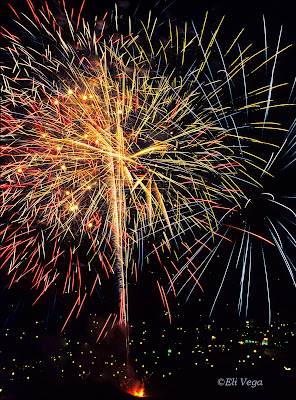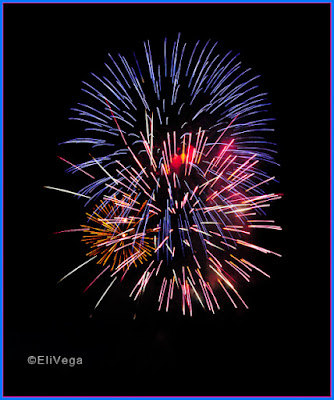PHOTOGRAPHING FIREWORKS
For my tip this month, I am going to give you all the details upfront, then show you several examples of fireworks. It's easier than you think. And, if you have a good quality DSLR, you don't even need to shoot 'RAW'-- just set your camera for JPEG Large or Fine, and set your picture control on 'Vivid.' Read your camera manual to learn how to select those settings.
Shooting fireworks is a lot of fun. When you're there, the display, the show, might last for 15, 20, or 30 minutes, but we can "capture" those split seconds of vibrant color, shapes, designs , and excitement to keep and store as forever memories.
Okay, so now that I have shared my excitement, let me talk about the techniques I use to create my fireworks images. First, shake off the notion that you're going for perfection. No. This is more art than science. Some of the 'works will be outside your viewfinder's view; some will be a little too high; some a little too low; some to the left. That said, my first tip is shoot, shoot, and keep shooting. However, don't be amateurish and just throw spaghetti on the wall, hoping some of it will stick. I am going to show you how to be artistically calculated; as opposed to just random and wishful shooting.
First, you need a tripod. Sorry, but you will need a good tripod. Not super expensive; just good-- not wobbly. It should extend four-five feet high, or higher, depending on your height. You need one that allows you to quickly adjust from vertical to horizontal, so you can vary your shots during the display. Most displays last from 15-20 minutes or so.
CAMERA SETTINGS:
Cable Release. I strongly recommend a good, reliable, quick, cable (or remote) release.
Lens. I recommend a zoom lens so you can be zooming in and out as needed. Obviously, if you are far away from the action, you'll need a stronger focal length. I like to be close to the action, like across a lake. Throughout the evening, I use a range of roughly 18mm to 40mm, with an APS (cropped) sensor, as opposed to a full-frame.
F/Stop. I like to shoot with a range of f/8-f/11. Why? As carefully as I manually focus where I think the 'works are going to explode, I'm never quite sure, so, that range of f/stop will assure me that everything will be nicely focused. For some of the shots I will share, I kept mine at f/11 throughout the display. F/11 also keeps a lot of the fireworks from being overexposed, i.e., it lets less light in during each burst.
Shutter Speed. I always use the BULB setting--that becomes my "shutter speed," as I'll explain later.
Exposure. Again, the BULB setting also helps me with my "exposure." I will share later what else I do to get my exposures for each fireworks bursts.
Image Format. Believe it or not, I have always shot all my firework displays in JPEG Large. I set my Picture Control to VIVID (your camera might have a different designation).
TECHNIQUE. Now that I have shared the left brain stuff, now let me share what I do once I have all the left brain stuff taken care of. I first wait until the first display--that gives me a hint as to where they have their equipment aimed, knowing that some will be off a little from that point. That is why I use wide focal lengths. I'd rather get a little more space than I need, and then crop my images later, if I need to. I vary my focal lengths, the position of my camera, and switch from horizontal to vertical shots during the evening.
Now, you might ask, what about that BULB setting? I usually have an opaque piece of material-- a camera manual, folded copy paper, etc. The key point is to take something to use as an improvised "lens cap." I recommend roughly 5"x7" or larger. It needs to cover the lens in-between each fireworks burst, yet flexible enough to remove it quickly when the next burst comes up. Believe it or not, that piece of folded-up paper becomes my "shutter."
Here is how I use that piece of paper as my "shutter." I place the piece of paper carefully in front of my lens, so it won't receive any light. THEN:
1) I see a beautiful display go up in the sky. I take the paper away from the front of the lens and trigger my cable release at the same time. Right before the display dissipates, I cover the lens again with my hand, BUT I don't let go of the cable release--thus the shutter in the camera is still open, but not receiving any light. I then see another colorful explosion. I take the paper away again, then cover my lens again when that second display begins to dissipate. Then I take my finger off my cable release. I have, in essence, created a double exposure, combining two displays! How fun is that?
2) I repeat the above process, but this time I do it for three firework displays, just to be different. Now, I've created a triple exposure. I've combined three displays in the same image!
3) I then repeat the above process, but just do it for one burst/display.
I go back and forth between steps 1-3 bursts, as described above, during the course of the evening, getting one, two, or three firework bursts in my images. It's fun, exciting, and can even be jaw-dropping.
Software fine-tuning. Most folks today call it "post processing." Actually, this process I follow requires only a little fine-tuning. All I do is crop (if necessary), burn, or dodge--darken some areas or lighten some areas of the images and maybe add some contrast.
As Forrest Gump once said, "Life is like a box of chocolates. You never know what you're gonna get."
So, with that, I hope you enjoy seeing samples of my previous fireworks. Have fun!
Most of these examples, unless otherwise designated, are from Estes Park, Colorado.
vegaphotoart@gmail.com www.elivega.net










No comments:
Post a Comment